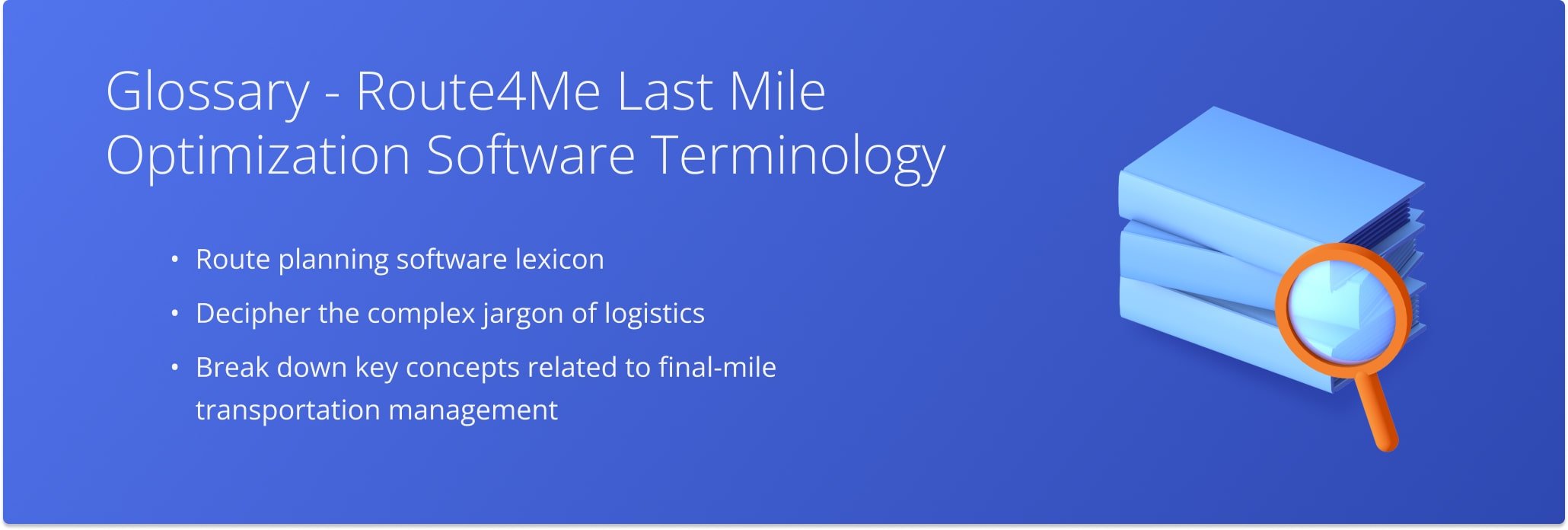Glossary – Route4Me Last Mile Optimization Software Terminology
Route4Me’s user-friendly last mile optimization software for enterprise businesses offers multiple web-based and mobile route planning solutions. If you encounter any unfamiliar terms while using our services, refer to this Glossary for comprehensive definitions of commonly used terms.

| Term | Definition |
|---|---|
| Activity Feed | A log for recording all real-time route actions performed by users, also accessible through your Route Editor. |
| Address | A specific location used for routing, which may be geocoded into latitude and longitude coordinates. Related terms: Location, Destination |
| Asset | A Vehicle or User in the field that is assigned tasks, such as deliveries or service stops. |
| Avoidance Zone | A designated area that a route should avoid due to restrictions, hazards, or other factors. |
| Capacity Profile | A set of parameters that define the available space, weight limits, or other constraints of a vehicle, helping to optimize route planning by ensuring that deliveries or services match the vehicle’s capacity. |
| Commercial Vehicle | A vehicle used for business operations, such as deliveries or services, which may have specific characteristics (e.g., size or capacity) that impact route planning and optimization. Related term: Vehicle, Fleet, Mixed Fleet |
| Cube | The total volumetric capacity of a vehicle, typically measured in cubic units, used to optimize load distribution in route planning. |
| Destination | Any location where a delivery or service is scheduled to occur within a route. Related terms: Address, Location |
| Dispatch | Assigning planned routes to drivers or field personnel. |
| Driver App | Route4Me mobile application used by drivers to receive routes, navigate, and capture delivery data. |
| Dynamic Start Time | A feature that allows the start time of a route to adjust automatically based on factors like traffic, delays, or changes in the schedule. Related term: Flexible Start Time |
| Facility | A location or building where operations such as storage, distribution, or service take place, often serving as a point in route planning for pickups or deliveries. |
| Fleet | Converting addresses or locations into geographic coordinates (latitude and longitude) to be used in route planning. Related term: Mixed Fleet |
| Geocoding | Converting addresses or locations into geographic coordinates (latitude and longitude) to be used in route planning. |
| Geofencing | Creating virtual boundaries on a map to monitor when a vehicle enters or exits a specific area. |
| Location | A specific point or area where a task or delivery is scheduled to occur, such as an address, facility, or geographical coordinate. Related terms: Address, Destination |
| Mixed Fleet | A fleet consisting of different types or models of vehicles used for various tasks within an operation. Related term: Fleet |
| Optimization Profile | A set of rules and preferences that define how routes should be optimized, such as avoiding specific road types, minimizing fuel consumption, or adhering to time windows for deliveries. |
| Order | A task to be completed, such as a delivery or service stop, within the context of a route plan. |
| Pieces | The number of individual items or packages assigned to a destination or route, used for capacity planning. |
| Planned Distance | The total distance calculated for a route, based on the planned sequence of stops and optimized for efficiency before the route is executed. |
| Proof Of Visit | Confirmation that a visit was completed, often captured through signatures, photos, or other electronic means. Related terms: Proof of Delivery, Proof of Service, Proof of Pickup |
| Revenue | The financial value associated with a route, stop, or delivery, often used for performance tracking and optimization. |
| Route ID | A unique identifier assigned to each route in Route4Me for tracking and management. |
| Route Manifest | A detailed overview of metrics, order details, and other important information associated with a specific route. |
| Service Time | The estimated duration required to complete a task at each destination. Related term: Wait Time |
| Snapshot | A detailed overview of activities associated with a route, user, vehicle, or telematics integration which helps you track route activity more easily. |
| Telematics | Technology that monitors and tracks vehicles and assets in real-time, often using GPS and other sensors. |
| Telematics Vehicle | A vehicle equipped with telematics technology that tracks and transmits real-time data, such as location, speed, and fuel consumption, to optimize fleet management and route planning. |
| Telematics Vendor | A third-party provider that supplies GPS tracking and vehicle telematics data for integration with Route4Me. |
| Territory | A defined geographic area used for organizing and optimizing routes within a specific region. |
| Time Windows | Specific time frames during which deliveries or services must occur, often set by customer or business requirements. |
| Users | Individuals who interact with the Route4Me platform, such as drivers, field teams, or administrators, each with specific permissions and responsibilities. |
| Vehicle | A transport unit used for executing planned routes, which can have specific attributes such as capacity, weight limits, and telematics integration. Related terms: Commercial Vehicle, Fleet |
| Vehicle ID | A unique identifier assigned to a vehicle within Route4Me for tracking and management. |
| Wait Time | The duration a driver or vehicle remains idle at a destination, impacting route efficiency and scheduling. Related Term: Service Time |
| Weight | The total load capacity of a vehicle, used to optimize routes based on weight restrictions and cargo limits. |
Visit Route4Me's Marketplace to Check out Associated Modules:
- Operations
Custom Data Add-On
- Operations
Advanced Team Management Add-On